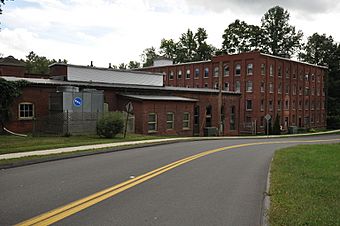J. B. Williams Co. Historic District facts for kids
Quick facts for kids |
|
|
J. B. Williams Co. Historic District
|
|
 |
|
| Location | Hubbard, Williams, and Willieb Sts., Glastonbury, Connecticut |
|---|---|
| Area | 75 acres (30 ha) |
| Architectural style | Greek Revival, Late Victorian, Colonial Revival |
| NRHP reference No. | 83001268 |
| Added to NRHP | April 7, 1983 |
The J. B. Williams Co. Historic District is a special area in Glastonbury, Connecticut. It includes an old factory from the 1800s and homes where the factory owners lived. This district is found around Hubbard, Williams, and Willieb Streets.
The area has a wooden factory building from the mid-1800s. It also features newer brick buildings. The homes belonged to the Williams family, who owned the factory. This soap factory was very important to Glastonbury's economy. It was one of the biggest businesses in the town. The district was added to the National Register of Historic Places in 1983. This means it is a historically important place.
Contents
A Factory's Journey
James B. Williams was born in Lebanon, Connecticut. In 1834, he moved to Manchester, Connecticut. There, he worked in a general store. He also started trying out different ways to make soap.
Starting the Soap Business
In 1840, James Williams opened a small shop in Manchester. He began making soap there, and it became very successful. His soap business grew quickly.
Moving to Glastonbury
In 1849, James Williams moved his business to Glastonbury. He bought land where his first father-in-law, Jerusha Hubbard, had a gristmill. This land was on the south side of Williams Street. This is where his soap factory really grew. Later, the business expanded to buildings on the north side of the street too.
Peak of Production
The J. B. Williams Co. factory was most successful in the 1920s. At its busiest, about 300 people worked there. It was the largest employer in Glastonbury. This means it gave jobs to more people than any other business in town.
Changes Over Time
The Williams family sold the company in 1957. Other companies continued to use the factory buildings. They kept making products there until 1977. Today, the old factory buildings have new life. The four brick buildings and the rare old wooden building are now homes.
Homes of the Williams Family
The historic district also includes several important homes. These houses belonged to the Williams family members. They show different styles of architecture from the past.
J.B. Williams' Mansion
In 1859, J.B. Williams built a grand brick house. It was designed in the Italianate style. This beautiful home was on Willieb Street. It sat on a hill, looking down over the factory.
Other Family Homes
J.B. Williams' son, David, built his house in 1892. It was on Williams Street. This home showed a mix of Queen Anne and Shingle architectural styles. Another son, Samuel, built a lovely Georgian mansion. This house was located on Hubbard Street.
The Oldest House
The oldest building in the district is a house from around 1740. It has been changed a lot over the years. People informally called it "Grandfather's House." This is because Jerusha Hubbard, J.B. Williams' father-in-law, lived there when Williams bought the land.



